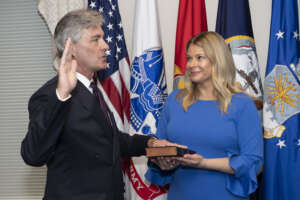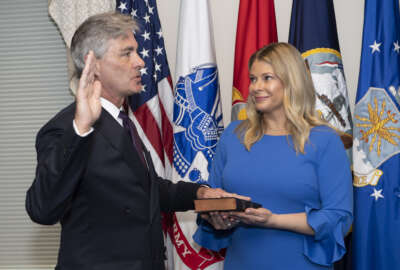Braithwaite sworn in as new Navy secretary after months of leadership tumult
Braithwaite is the first Senate-confirmed Navy secretary since last November, when the Trump Administration fired Richard Spencer.
The DoD Reporter’s Notebook is a weekly summary of personnel, acquisition, technology and management stories that may have fallen below your radar during the past week, but are nonetheless important. It’s compiled and published each Monday by Federal News Network DoD reporters Jared Serbu and Scott Maucione.
New Navy secretary vows to lead sea services through “rough waters”
Kenneth Braithwaite took the oath of office to become the 77th secretary of the Navy on Friday, ending a long stretch during which the Navy Departments top job has been vacant, and at times, mired in turmoil.

Braithwaite is the first Senate-confirmed Navy secretary since last November, when the Trump Administration fired Richard Spencer. In a message to sailors and Marines on Friday, the former U.S. ambassador to Norway called the latest appointment “the honor of my life,” but also a significant challenge.
“Our nation is up against perhaps the greatest test of our commitment to the ideals we hold dear than at any time in our history … surely since the end of World War II,” Braithwaite wrote. “We must recognize this challenge for all it is and all it presents, lurking in the shadows of deceit or the depths of dishonesty. However, our Navy and Marine Corps have faced tough times before. Each time we have prevailed and we will persevere again.”
Braithwaite didn’t elaborate on what he meant by “deceit” or “dishonesty.”
But he’d also alluded to major leadership challenges for the Navy during his Senate confirmation hearing. His testimony came just a month after Thomas Modly, the undersecretary who was also acting Navy secretary, was also forced to resign over his handling of the aftermath of a coronavirus outbreak aboard the USS Theodore Roosevelt.
“It saddens me to say that the Department of the Navy is in rough waters due to many factors, but primarily the failure of leadership,” Braithwaite testified. “Whether Glenn Marine Defense, the ship collisions in 2017, judicial missteps, or the crisis recently aboard USS Roosevelt, they’re all indicative of a breakdown in the trust of those leading the service.” —JS
DoD wants up to $1B in contractor help for business transformation
Just a few weeks after the Defense Business Board issued a scathing report that concluded the Pentagon’s chief management officer (CMO) has largely failed in its mission of enterprise-wide business transformation, the CMO’s office is turning to industry for help. A lot of help.
In a new sources sought notice, the CMO shop says it’s contemplating a new support services contract that’s likely to be worth anywhere between $250 million and $1 billion over the next five years. The list of potential services in the forthcoming indefinite-delivery/indefinite quantity (ID/IQ) contract is voluminous, but they’re focused in three major categories to support business reform:
- Management and Professional Services
- Studies, Research, and Analyses
- Evaluation Expertise
The CMO’s office is still in the market research stage and hasn’t announced when it might issue a formal request for proposals. As of now, it’s hoping for participation from both large and small businesses, including 8(a) firms, HUBZone and other economically disadvantaged small businesses.
And although the contract would be a multiple-award ID/IQ, companies wouldn’t be able to stay on the contract vehicle forever unless they show they’re helping. Firms who pass up two task order requests in a row without offering a bid would be “off-ramped.” Companies whose technical approach is rated “marginal” at least twice would get the same treatment.
The overall goal, officials wrote, is to help develop “transformational solutions” to DoD’s business reform challenges.
“This will be accomplished through seven objectives: Deliver performance at the speed of relevance; organize for innovation; drive budget discipline and affordability; streamline rapid, iterative approaches from development to fielding; contract management; contract efficiency assessment, and harness and protect the National Security Innovation Base, officials wrote.” —JS
The new normal
The Navy is trying to figure out what the “new normal” will look like for its sailors and civilians when they start returning to their physical work locations. The Naval District Washington Recovery Working Group is developing plans for when health regulations loosen.
“We’ve had a reversal of the norm,” said Jeff Sanford, NDW recovery working group chair. “Before the pandemic, NDW on average probably had 10% of its workforce teleworking every day. “But because of COVID-19, we probably have over 90% of our personnel teleworking. Finding a way to get those people back into the office is now the big challenge.”
The group is trying to decide how it will bring people back onto installations and how many to bring back at one time. One concern is the amount of supplies that will be needed like face masks, hand sanitizer and cleaning material.
According to Defense Department guidelines, installations can’t change health restrictions until there is a 14-day decline of coronavirus cases in the area. — SM
Lobbying law showdown
A month ago, House Armed Services Personnel Subcommittee Chairwoman Jackie Speier (D-Calif.) Rep. Katie Porter (D-Calif.) and three other lawmakers asked the Defense Department to reconsider its legislative proposal to weaken lobbying laws. The Defense Department is back with a response and it’s sticking to its guns for now.
The legislative proposal would change some of the wording around the existing lobbying law. It would restrict “lobbying contacts” a loosely defined term, instead of “lobbying activities,” which is currently in the law.
DoD General Counsel Paul Ney wrote that lobbying activities prohibits some “behind-the-scenes assistance” while contacts does not.
“With the exception of the President’s Ethics Pledge, which applies to former senior and non-senior political appointees, no other post-government employment restriction prohibits former senior officials from participating in behind-the-scenes assistance,” Ney wrote.
The proposal would also lessen the two-year cooling off period from when high ranking military officers leave the service and when they can join a defense company.
“DoD’s proposed changes align section 1045 with the criminal statute without changing the existing two-year ‘cooling-off’ period for general of flag officers and their civilian equivalents,” Ney wrote. — SM
A new future
The Army is thinking differently about how biology will fit into the way the military operates. Army Futures Command leader Gen. Mike Murray says after seeing the effects of COVID-19 it is preparing differently for the decades to come.
“What we are working on now is really four alternative futures,” Murray said. “The further out you go the wider it gets and then we can begin to work our way back. Part of Futures Command is medical research and I’ve got some really smart people.”
Those “smart people” told Murray something that stuck with him when thinking about pandemics.
“Over a 60 year period we had two new coronaviruses and in the last 16 years we’ve had five new coronaviruses emerge in the world,” Murray said. “I absolutely think this type of event has to be a part of how we look into the future.” — SM
Defense contractors still have COVID-related liability concerns
When it comes to companies’ liability for their employees becoming sick with coronavirus as people return to work, the consensus among legal experts is that employers are on fairly safe ground if they follow reasonable standards of care, like CDC guidelines and local public health orders.
Even those measures aren’t a complete safe harbor, and things are more complicated for companies doing business in the Defense industry, since the Pentagon has designated them as “critical infrastructure” since the start of the pandemic.
According to the National Defense Industrial Association, questions about COVID liability issues are still a concern for many of its members.
“If you follow the CDC guidelines and you follow the PPE guidelines for the government entity you’re working for and somebody does get sick, where is the liability, and how do companies cover that? Much of our industry is really concerned about this,” he said Friday during a panel hosted by the Center for Strategic and International Studies. “The bigger companies probably have a better capability to cover that, but some of our small businesses might not. This is some of the under-the-radar stuff that people are really starting to wrestle with as we go forward.”
In a survey earlier this month, one of the concerns companies expressed to NDIA was how much liability they could face once their government customers transition back to normal office conditions. For instance, if one of their workers becomes infected at a federal worksite, is the contractor liable, or is the government? —JS
Women in the Space Force
The Space Force debuted its first recruiting ad late last week. One thing that stands out: There are a lot of women in the ad. Women astronauts, cyber warriors and commanders all make an appearance. A woman also narrates the ad. It elucidates the military’s push for more diversity in its ranks.
However, as we reported last week, the military isn’t exactly winning the battle when it comes to recruiting and retaining women. The Government Accountability Office released a study that found the proportion of women in the military only went up from 15.1% to 16.5% over a 15 year period.
Women were also 28% more likely to leave the service than men.
The Space Force ad certainly seems like it’s making a push to change that, but GAO says the military needs more than just recruiting ads.
“Without DoD guidance and service plans with goals, performance measures, and timeframes to monitor female recruitment and retention efforts, DoD may continue to miss opportunities to recruit and retain a valuable segment for its active-duty force,” the report authors stated. — SM
Copyright © 2024 Federal News Network. All rights reserved. This website is not intended for users located within the European Economic Area.
Jared Serbu is deputy editor of Federal News Network and reports on the Defense Department’s contracting, legislative, workforce and IT issues.
Follow @jserbuWFED
Scott Maucione is a defense reporter for Federal News Network and reports on human capital, workforce and the Defense Department at-large.
Follow @smaucioneWFED





